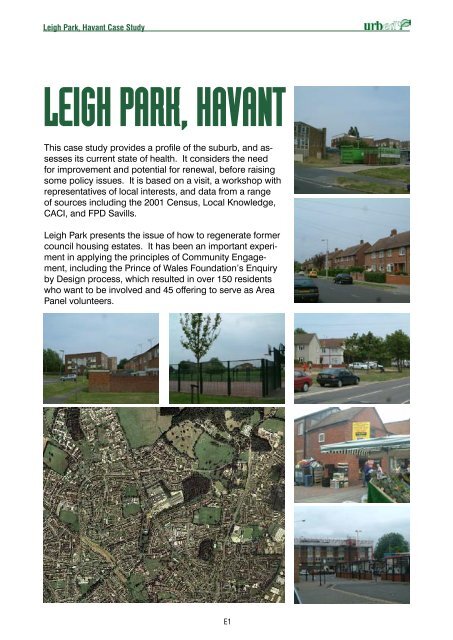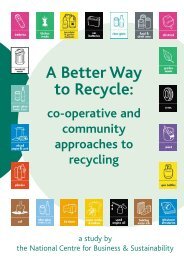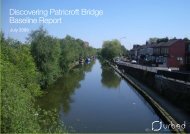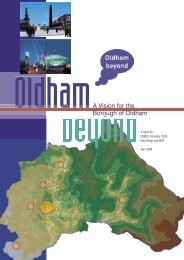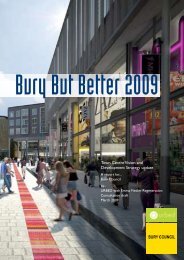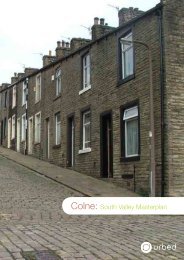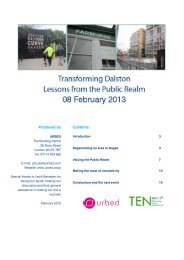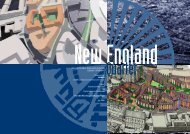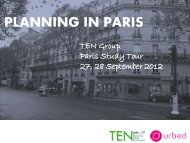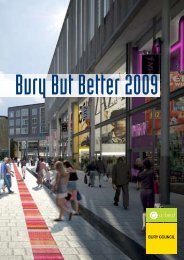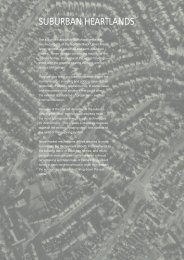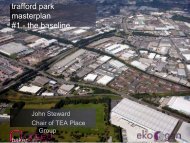Market* report on Leigh Park - Urbed
Market* report on Leigh Park - Urbed
Market* report on Leigh Park - Urbed
Create successful ePaper yourself
Turn your PDF publications into a flip-book with our unique Google optimized e-Paper software.
<strong>Leigh</strong> <strong>Park</strong>, Havant Case Study<br />
LEIGH PARK, HAVANT<br />
This case study provides a profile of the suburb, and assesses<br />
its current state of health. It c<strong>on</strong>siders the need<br />
for improvement and potential for renewal, before raising<br />
some policy issues. It is based <strong>on</strong> a visit, a workshop with<br />
representatives of local interests, and data from a range<br />
of sources including the 2001 Census, Local Knowledge,<br />
CACI, and FPD Savills.<br />
<strong>Leigh</strong> <strong>Park</strong> presents the issue of how to regenerate former<br />
council housing estates. It has been an important experiment<br />
in applying the principles of Community Engagement,<br />
including the Prince of Wales Foundati<strong>on</strong>’s Enquiry<br />
by Design process, which resulted in over 150 residents<br />
who want to be involved and 45 offering to serve as Area<br />
Panel volunteers.<br />
E1
<strong>Leigh</strong> <strong>Park</strong>, Havant Case Study<br />
What type of suburb is <strong>Leigh</strong> <strong>Park</strong>?<br />
Defined by ONS as mainly suburban urban with a small suburban rural area<br />
Density: number of households per hectare (ONS)<br />
A mixed area but mainly lower density below 30 - 50<br />
Physical features<br />
a. Locati<strong>on</strong> The estate is just off the<br />
A3 (M), and about ten minutes drive<br />
North of the centre of Havant, with good<br />
bus links to Portsmouth. Surrounded<br />
by attractive countryside, including the<br />
Staunt<strong>on</strong> Country <strong>Park</strong>, it is quite close<br />
to some major industrial estates. It is<br />
also <strong>on</strong>ly a few miles from Waterlooville<br />
(The Purbrook, Waterlooville, Cowplain<br />
area) which composes mainly post-war<br />
suburban development, with plans for a<br />
further 2-3,000 homes as part of a Major<br />
Development Area.<br />
b. Age <strong>Leigh</strong> <strong>Park</strong> was a post-war<br />
phased development. It was intended as<br />
a New Town, initially to house those who<br />
had been ‘bombed out’ of Portsmouth or<br />
who were living in overcrowded c<strong>on</strong>di-<br />
ti<strong>on</strong>s, with a planned populati<strong>on</strong> of 40,000<br />
(which was never reached). The current<br />
level is 27,000 living in 11,500 houses,<br />
as average household sizes have fallen.<br />
Source: ONS and DETR<br />
In its day it was promoted as ‘the Garden<br />
City of the South’, but looks like a typical<br />
low-rise Council estate. By 1951, 7,000<br />
people lived in <strong>Leigh</strong> <strong>Park</strong>, largely in<br />
semis, and much of the remaining hous-<br />
ing was built in the succeeding decades,<br />
and included some system-built housing.<br />
There has been virtually no new housing<br />
in the last ten years, but there has been<br />
some home improvement, and restorati<strong>on</strong><br />
of the system-built homes. The majority<br />
of houses that have not been sold under<br />
the ‘Right to Buy’ are owned and man-<br />
aged by Portsmouth County Council.<br />
c. Layout The estate c<strong>on</strong>sists of three<br />
main parts, known as <strong>Leigh</strong> <strong>Park</strong> Central,<br />
West <strong>Leigh</strong>, and Warren <strong>Park</strong>, plus a<br />
distinct centre known as Greywell/<strong>Park</strong><br />
Parade, though a number of other ‘neigh-<br />
bourhoods’ can be identified:<br />
•The early parts are largely made up of<br />
two storey red brick terraces, <strong>on</strong> curving<br />
Source: CACI<br />
Reproduced from the Ordinance Survey mapping with the permissi<strong>on</strong> of the C<strong>on</strong>troller of Her Majesty’s Stati<strong>on</strong>ery<br />
Office © Crown copyright. Unauthorised reproducti<strong>on</strong> infringes Crown copyright and may lead to prosecuti<strong>on</strong> or civil<br />
proceedings. South East England Regi<strong>on</strong>al Assembly. Licence No. 0100037971 (2004).<br />
Dominant Acorn Type Group (with transport links shown)<br />
• Blue Collar Roots • Post Industrial Families<br />
• Prudent Pensi<strong>on</strong>ers<br />
Source: Census 2001 Source: Census 2001<br />
Dominant House Type (ONS)<br />
• Terraced • Purpose build block of flats or tenements<br />
• Semi-detached • In commercial buildings<br />
E2<br />
roads off wide and relatively straight main<br />
roads.<br />
• Warren <strong>Park</strong> differs in being largely built<br />
<strong>on</strong> Radburn principles that separate pe-<br />
destrians and cars, with a number of four<br />
storey blocks of flats, and a significant<br />
open space running through the middle.<br />
• Greywell/<strong>Park</strong> Parade is pedestrianised,<br />
and c<strong>on</strong>sists largely of two storey flats<br />
over shops, which face inwards. There<br />
is a new Sure Start centre providing a<br />
nursery for working parents.<br />
• The overall density is relatively low<br />
at 10.5 houses per hectare, but with<br />
variati<strong>on</strong>s in terms of the amount of open<br />
space, and garden size.<br />
• The areas with the most development<br />
potential are <strong>on</strong> the edge, particularly near<br />
the A3 (M), and the Procter and Gamble<br />
site, which covers 8.3 hectares.
<strong>Leigh</strong> <strong>Park</strong>, Havant Case Study<br />
Neighbourhood features<br />
a. Role <strong>Leigh</strong> <strong>Park</strong> is becoming more<br />
of a ‘dormitory’ suburb as a result of<br />
ec<strong>on</strong>omic and demographic changes.<br />
It is classified by CACI as largely ‘post<br />
industrial families’, and in the past has<br />
provided affordable housing to working<br />
class families who originally worked in<br />
the Dockyards, and then post war in the<br />
factories that thrived in Havant, such as<br />
Procter and Gamble and Kenwood. The<br />
number of local jobs has decreased sig-<br />
nificantly for example Procter and Gamble,<br />
<strong>on</strong>ce employing 1000, is closing down.<br />
The Planning Brief for the site hopes to<br />
attract a mix of uses, including space for<br />
350 jobs that will be lost.<br />
b. Image and identity In spite of an in-<br />
crease in owner occupati<strong>on</strong>, there is still a<br />
stigma associated with the area. However<br />
the schools and health centres might help<br />
to provide a sense of local identity.<br />
c. Demographics The area is relatively<br />
homogenous, with 32% within the age<br />
group 20-44, and with 65% family<br />
households. 45% of all households have<br />
children, and 37% of all households have<br />
dependent children. Four wards show<br />
high c<strong>on</strong>centrati<strong>on</strong>s of deprivati<strong>on</strong>, and<br />
have attracted £8 milli<strong>on</strong> of Single Re-<br />
generati<strong>on</strong> Budget funding (plus matched<br />
funding).<br />
There is a high level of out commuting<br />
(55,000 ec<strong>on</strong>omically active residents,<br />
but <strong>on</strong>ly 37,000 jobs within the borough).<br />
d. Housing demand Little new housing<br />
has been built until recently, and there has<br />
been a degree of inertia that has inhibited<br />
development of several publicly owned<br />
sites. Further some of the applicati<strong>on</strong>s<br />
have been c<strong>on</strong>sidered inappropriate.<br />
However now that 45% of the houses<br />
are privately owned (acquired under the<br />
‘Right to Buy’) the area offers some of the<br />
cheapest housing available near the South<br />
Coast. New people, especially ‘aspirant<br />
young couples’ are seeing the area as a<br />
‘first rung <strong>on</strong> the ladder’. They will tend<br />
to use cars to get to work, possibly add-<br />
ing to the pressure <strong>on</strong> parking spaces.<br />
On the whole, however, the area is rela-<br />
tively stable, with low rates of turnover,<br />
but is gradually changing in some ways<br />
that may make it less sustainable:<br />
• Households receiving state benefit<br />
As social housing is allocated according<br />
to need <strong>Leigh</strong> <strong>Park</strong>’s populati<strong>on</strong> reflects a<br />
higher proporti<strong>on</strong> of ec<strong>on</strong>omically inactive<br />
households e.g. young single mothers.<br />
• Elderly poor As children have left<br />
home, there are significant numbers of<br />
people living <strong>on</strong> limited incomes in large<br />
houses that are expensive to heat and<br />
maintain; there seems to be relatively little<br />
housing designed with the needs of the<br />
E3<br />
elderly in mind.<br />
• Loss of young people With prices<br />
having increased from £71k to £120k in<br />
the last two years, there is a real shortage<br />
of intermediate housing, and there is c<strong>on</strong>-<br />
cern that local young people cannot afford<br />
what is available, and in order to become<br />
independent are ending up in ‘bed sits’ in<br />
Portsmouth.<br />
e. Social infrastructure The area enjoys<br />
a good range of schools and social<br />
services, though the quality is not what it<br />
needs to be if the area is to become more<br />
socially balanced. There are some local<br />
shops, and there is a large new Asda/<br />
Walmart superstore <strong>on</strong> the edge. Taxis<br />
are often used to bring shopping back,<br />
with several people sharing a taxi.<br />
Previous c<strong>on</strong>sultati<strong>on</strong> has revealed a<br />
number of key issues for the community<br />
including the need to:<br />
• improve transport (particularly more<br />
direct bus routes, and easier access to<br />
services e.g. hospital)<br />
• articulate local identity (to help over-<br />
come the stigma and rather dreary looking<br />
streets)<br />
• extend leisure facilities (particularly<br />
places for young people to go)<br />
• tackle crime (particularly car theft)<br />
• facilitate enterprise<br />
• develop community schools
<strong>Leigh</strong> <strong>Park</strong>, Havant Case Study<br />
Health of the suburb:<br />
priorities and opportunities<br />
for improvement<br />
The first part of the workshop comprised<br />
a scoring/ranking exercise using a ten cat-<br />
egory scorecard (5 physical and 5 social<br />
characteristics). Participants were asked<br />
to score questi<strong>on</strong>s within each of the ten<br />
categories, and the results used to stimu-<br />
late discussi<strong>on</strong> and reach c<strong>on</strong>sensus<br />
<strong>on</strong> priorities. A further ranking exercise<br />
enabled the priority categories below to<br />
be identified, together with some ideas for<br />
improvement.<br />
Commerce Havant needs to encour-<br />
age more start-ups, including Commu-<br />
nity Businesses, in order to adapt to a<br />
changing ec<strong>on</strong>omy, and to overcome the<br />
‘dockyard culture’ it has inherited (which<br />
includes third generati<strong>on</strong> unemployed).<br />
The Procter and Gamble site provides a<br />
first class opportunity to do this (see sec-<br />
ti<strong>on</strong> Room for renewal and redevelopment<br />
below).<br />
Character There is too much uniform-<br />
ity, with a predominance of two storey<br />
brick semis and terraces. New housing is<br />
needed that will look different, and make<br />
<strong>Leigh</strong> <strong>Park</strong> as a whole more diverse<br />
Possible improvements:<br />
a. Improved public realm This might<br />
include revisiting street names, providing<br />
more places to sit, and making better use<br />
of the green verges (likely to be lost to car<br />
parking)<br />
b. <strong>Park</strong>ing courts Soluti<strong>on</strong>s need to be<br />
found that provide greater security without<br />
taking over fr<strong>on</strong>t gardens e.g. echel<strong>on</strong><br />
parking<br />
Capacity Even more important than the<br />
NEIGHBOURHOOD SCORE CARD - LEIGH PARK<br />
* 1. Poor ** 1 to 5 where<br />
2. Adequate 1 = least important and<br />
3. Good 5 = very important<br />
A. Physical capital<br />
1. Choice<br />
Score* Rank**<br />
• can the area accommodate the stages in a family’s life cycle?<br />
• does it offer a mix of house types and affordability?<br />
2. C<strong>on</strong>nectivity<br />
1<br />
1<br />
3<br />
• can you reach services and jobs without too much stress?<br />
• are there basic shops and quality open space within easy walking or<br />
2<br />
2<br />
cycling distance?<br />
3. C<strong>on</strong>servati<strong>on</strong><br />
2<br />
• are natural resources being saved e.g. energy, water, materials (waste)?<br />
• is bio-diversity being encouraged e.g. trees, wildlife?<br />
2<br />
2<br />
2<br />
4. Character<br />
• does the area look attractive and cared for?<br />
• has new development enhanced the area?<br />
5. Commerce<br />
• are there other uses in the area, such as employment or leisure?<br />
• are there places to set-up a business?<br />
B. Social capital<br />
1. Community<br />
• do people feel a sense of pride?<br />
• does the area readily accept newcomers?<br />
2. Civic life<br />
• are there enough places to meet others e.g. pubs, clubs, open spaces?<br />
• are the shops and services welcoming?<br />
3. Crime<br />
• do residents feel safe when they go out?<br />
• do residents feel their property is safe?<br />
4. Climate for enterprise<br />
• is it a good place to start a business?<br />
• is there sufficient purchasing power to support local businesses?<br />
5. Capacity (and quality) of services<br />
• can you get to see a doctor without a l<strong>on</strong>g wait?<br />
• can you get into an acceptable sec<strong>on</strong>dary school without a l<strong>on</strong>g journey?<br />
numbers of doctors or teachers, is the<br />
quality of the services<br />
Possible improvements:<br />
a. A new primary health centre Possibly<br />
developed through the LIFT programme,<br />
this might also help in articulating local<br />
identity.<br />
b. ‘Alternative sports’ There is prior-<br />
ity need for activity that can engage the<br />
interests and energy of young people, for<br />
example through a sports centre or gym<br />
facilities, or assisting young people to ac-<br />
cess existing facilities.<br />
E4<br />
c. Play facilities A range of play spaces<br />
are called for that can help strengthen<br />
community spirit (and incidentally make<br />
the area look more inviting). One idea<br />
was to c<strong>on</strong>vert an older industrial building<br />
into a multi-use centre with a central play<br />
court with seating that could be used vari-<br />
ously for tournament games, as a cinema,<br />
or a theatre.<br />
1<br />
1<br />
1<br />
1<br />
3<br />
1<br />
2<br />
1<br />
1<br />
1<br />
1<br />
2<br />
2<br />
2<br />
Crime Some progress is being made,<br />
through a local police office with 16 offic-<br />
ers and a sergeant, and police now ride<br />
around <strong>on</strong> bikes making their presence<br />
4<br />
5<br />
3<br />
4<br />
2<br />
5<br />
1
<strong>Leigh</strong> <strong>Park</strong>, Havant Case Study<br />
much more visible. A multi agency ap-<br />
proach is also being used.<br />
Possible improvements:<br />
a. Layout changes Fundamental changes<br />
to the layout of some areas would help<br />
e.g. turning the Radburn blocks into<br />
streets and courtyards<br />
b. Housing development More housing<br />
near the centre e.g. for elderly, would cre-<br />
ate more eyes <strong>on</strong> the street<br />
c. ‘Hang out’ places and spaces As<br />
well as sporting facilities young people<br />
need safe places to just ‘hang out’, such<br />
as skate board parks (two of which have<br />
already been provided in Warren <strong>Park</strong> and<br />
West <strong>Leigh</strong>). However these must be<br />
carefully sited to avoid oppositi<strong>on</strong>.<br />
C<strong>on</strong>nectivity Radical proposals have<br />
been made to improve the links, and there<br />
is scope to downgrade some of the main<br />
roads, and use some of the open space to<br />
better effect (which accounts for a quarter<br />
of the land area). While buses have been<br />
improved, and an improved bus stati<strong>on</strong> in<br />
Havant Town Centre is planned, walking<br />
and cycling look unsafe, and car usage is<br />
likely to grow substantially. Issues of safe<br />
play space, and improved walking/cycling<br />
routes also arose.<br />
Possible improvements:<br />
a. Home z<strong>on</strong>es One way of rec<strong>on</strong>ciling<br />
cars and children is the reallocati<strong>on</strong> of<br />
space, as has been d<strong>on</strong>e successfully in<br />
many Dutch towns with ‘wo<strong>on</strong>erfs’, and<br />
which is being tried out in the UK in a<br />
number of places<br />
b. Safe walking and cycling One reas<strong>on</strong><br />
C<strong>on</strong>tinental suburbs work better is that the<br />
car is not allowed to dominate residential<br />
areas, and instead both pavements and<br />
cycle ways form c<strong>on</strong>tinuous direct net-<br />
works that are safe and pleasant to use,<br />
Urban Design Principles<br />
· developing a new quarter with its own identity and<br />
character, while enhancing the town<br />
· raising the density to an acceptable and appropriate<br />
level<br />
· plugging into adjacent streets to increase permeability.<br />
with the minimum of c<strong>on</strong>flict.<br />
Choice There is too little choice, par-<br />
ticularly as far as the intermediate market<br />
is c<strong>on</strong>cerned. <strong>Leigh</strong> <strong>Park</strong> is not going to<br />
attract executive housing, but it should be<br />
easier to find a first independent home,<br />
which includes providing more smaller<br />
units, (and <strong>on</strong>es that can be expanded<br />
or upgraded as resources allow). Other<br />
gaps include modern housing for the<br />
elderly, and accommodati<strong>on</strong> for key work-<br />
E5<br />
ers. Though there is a desperate need for<br />
social housing, it was felt that greater bal-<br />
ance was needed as a whole.<br />
Illustrative <strong>on</strong>ly<br />
Room for renewal and<br />
redevelopment<br />
In additi<strong>on</strong> to the above improvements<br />
there is the following potential for the<br />
area to become more sustainable through<br />
renewal and development. However<br />
the Inspector’s review of the Local Plan<br />
paradoxically cut the requirement from
<strong>Leigh</strong> <strong>Park</strong>, Havant Case Study<br />
an extra 300 units by 2011 down to 250.<br />
Yet values have risen to a level where<br />
<strong>Leigh</strong> <strong>Park</strong> can now attract private invest-<br />
ment, and the community has begun to<br />
understand the value of higher density<br />
development.<br />
• Sustainable urban neighbourhoods<br />
There is a major opportunity to develop<br />
the Procter and Gamble site as a mixed<br />
use development. It should yield at least<br />
200 new homes, and could be viewed as<br />
a dem<strong>on</strong>strati<strong>on</strong> project for sustainable<br />
design e.g. Zero Energy Development. It<br />
might also attract innovative people into<br />
the area, and go some way to creating a<br />
more balanced and diverse populati<strong>on</strong>.<br />
The planning brief for the site provides for<br />
three hectares of industrial units, but there<br />
may not be sufficient demand. However<br />
there is a need for business incubators<br />
offering flexible space, and part of the in-<br />
dustrial space might be given over to this<br />
use. This would also ensure that there<br />
were a few early rungs <strong>on</strong> the premises<br />
ladder to house expanding businesses.<br />
A masterplan for the Procter and Gamble<br />
site, which lies between the main road<br />
and the shopping centre, would provide<br />
the means of showing not <strong>on</strong>ly the oppor-<br />
tunity for housing and employment uses,<br />
but also the reinforcement of Greywell/<br />
<strong>Park</strong> Parade, possibly with a healthy living<br />
centre, council office and even a small<br />
cinema.<br />
Redundant pubs such as The Her<strong>on</strong> offer<br />
another redevelopment opportunity, and<br />
have the added advantage of existing car<br />
park space.<br />
Other possible opportunities include:<br />
• Home extensi<strong>on</strong>s and improvements<br />
Relatively low house values and frag-<br />
mented ownership rule out redevelopment<br />
of existing blocks, but there are a number<br />
of opportunities for making the housing<br />
stock more sustainable: For example, lo-<br />
cal building skills and DIY can be tapped<br />
in order to reducing energy loss through<br />
both double glazing and external render.<br />
Extra space could be created e.g. by<br />
developing sun rooms, c<strong>on</strong>servatories,<br />
fr<strong>on</strong>t porches, loft extensi<strong>on</strong>s. This may<br />
also make multiple occupati<strong>on</strong> less prob-<br />
lematic.<br />
• Community hubs The development<br />
of both schools and local health centres,<br />
with grouped practices, can also be used<br />
to provide community facilities eg meeting<br />
space, play space, in walking distance of<br />
where people live.<br />
Recommendati<strong>on</strong>s for<br />
policy<br />
Former Council estates such as <strong>Leigh</strong><br />
<strong>Park</strong> throw up a distinct set of policy is-<br />
sues, which do not apply to other types<br />
of suburb:<br />
• Area Management Places like <strong>Leigh</strong><br />
<strong>Park</strong> should not have to rely <strong>on</strong> their levels<br />
of deprivati<strong>on</strong> in order to receive special<br />
E6<br />
attenti<strong>on</strong>. They require c<strong>on</strong>tinuous and<br />
locally based Area Management. In par-<br />
ticular local authorities need to take the<br />
lead in the planning of new facilities and<br />
in setting out how public land should be<br />
used to make communities more sustain-<br />
able. Making <strong>Leigh</strong> <strong>Park</strong> sustainable re-<br />
quires a substantial time period of acti<strong>on</strong><br />
e.g. tangible results are <strong>on</strong>ly just starting<br />
to show since SEEDA put in funding two<br />
and a half years ago.<br />
• Multi Agency Working Further, in areas<br />
with high levels of deprivati<strong>on</strong> it is crucial<br />
to get ‘joined up working’ in the delivery<br />
of services, e.g. health and housing. In<br />
additi<strong>on</strong> there may be a need for extensive<br />
social work and community interventi<strong>on</strong> in<br />
order to overcome problems such as drug<br />
and alcohol addicti<strong>on</strong>.<br />
Council estates inevitably have people<br />
with high levels of dependency, for exam-<br />
ple l<strong>on</strong>g-term illness and teenage preg-<br />
nancy, and who are reliant <strong>on</strong> good public<br />
transport.<br />
• Design Guides There is an interest<br />
in developing guidance or rules that can<br />
encourage appropriate development and<br />
improvement from the ‘bottom-up’ rather<br />
than relying just <strong>on</strong> the negative Develop-<br />
ment C<strong>on</strong>trol process. This could include<br />
specifying the ways in which houses can<br />
be extended, and safe parking spaces<br />
provided.
<strong>Leigh</strong> <strong>Park</strong>, Havant Case Study<br />
Some ‘stunning’ modern design is needed<br />
if <strong>Leigh</strong> <strong>Park</strong> is ever to escape its legacy<br />
of ‘boring streets’. Visi<strong>on</strong> for Havant rec-<br />
ommended the use of study tours, and a<br />
Housing Plan that would take account of<br />
the range of needs and potential develop-<br />
ment sites. A practical design guide is<br />
urgently needed to influence the develop-<br />
ment of schemes like the Procter and<br />
Gamble site, the new community schools,<br />
and the primary health centre. It should<br />
tap into experience elsewhere in South<br />
East England e.g. Kent, Surrey and Essex,<br />
but also might gain inspirati<strong>on</strong> from expe-<br />
rience abroad e.g. the Netherlands.<br />
• Masterplans Securing a balanced<br />
mix of uses where there are major sites<br />
like Procter and Gamble to be developed<br />
requires a masterplan. In high risk/low<br />
value situati<strong>on</strong>s, the public sector needs<br />
to take the lead, working with potential<br />
private developers or the site owner. The<br />
Development Brief issues for the Procter<br />
and Gamble Site in June 2004 does not<br />
provide much guidance <strong>on</strong> how the site<br />
should be laid out, or specify how much<br />
funding should be allocated to providing<br />
community benefits. The valuable work<br />
d<strong>on</strong>e so far <strong>on</strong> Creating Quality Places,<br />
and involving the community needs to<br />
be developed further if a key opportunity<br />
is not to be lost to change the look of a<br />
principal gateway, and to attract more en-<br />
trepreneurial people to live in <strong>Leigh</strong> <strong>Park</strong>.<br />
• SMART Transport With rising levels<br />
of car usage, acti<strong>on</strong> is needed now to<br />
provide attractive alternatives if places like<br />
<strong>Leigh</strong> <strong>Park</strong> are not to end up dominated by<br />
cars, while many people remain depend-<br />
ent <strong>on</strong> poor public transport. Possible<br />
tools include Quality Bus Corridors, car<br />
sharing (using mobile ph<strong>on</strong>es to facilitate<br />
arrangements), and a cycling campaign<br />
(with cycling courses and hire schemes),<br />
but all rely <strong>on</strong> changing attitudes, as the<br />
car will be seen as a smarter, cheaper,<br />
and more reliable opti<strong>on</strong> by many. There<br />
may be the potential to set up a commu-<br />
nity business to promote alternatives, per-<br />
haps using some form of alternative fund-<br />
ing e.g. Time Banks. Acti<strong>on</strong> to reallocate<br />
pavement and road space to provide safe,<br />
c<strong>on</strong>tinuous and direct cycle ways may<br />
need to be carried out at the same time.<br />
Ideally cycle ways would link to schools,<br />
health facilities, shops and bus routes.<br />
• Delivery vehicles The regenerati<strong>on</strong> or<br />
‘restorati<strong>on</strong>’ of <strong>Leigh</strong> <strong>Park</strong> has become<br />
<strong>on</strong>e of SEEDA’s priorities, and an Enquiry<br />
by Design process engaged the com-<br />
munity in the development of an Envir<strong>on</strong>-<br />
mental Improvement Plan, with funding<br />
under the ODPM’s Design Initiative. In<br />
order to maintain the momentum of this<br />
exercise, and given limited capital funds<br />
E7<br />
and a shortage of staff with the time and<br />
capacity to manage regenerati<strong>on</strong> projects,<br />
the Creating Quality Places project part-<br />
ners (SEEDA, Havant Borough Council,<br />
Portsmouth City Council and Hampshire<br />
County Council) are c<strong>on</strong>sidering the crea-<br />
ti<strong>on</strong> of a Special Purpose Delivery Vehicle.<br />
This needs to overcome the problem of<br />
ensuring there is a visi<strong>on</strong> shared by all the<br />
Authorities, and the capacity to involve<br />
development partners where there are a<br />
number of different land owners particu-<br />
larly Portsmouth City Council.<br />
However, <strong>Leigh</strong> <strong>Park</strong>, which is larger than<br />
a small town, needs more than <strong>on</strong>e form<br />
of partnership. With the development of<br />
major sites there is the potential to set up<br />
a community Development Trust with a<br />
property base to allow for rental income<br />
to fund initiatives. An alternative model<br />
is that of a Groundwork Trust to promote<br />
better use and refurbishment of public<br />
open space.<br />
There may also be scope for setting<br />
up the equivalent of an Urban Regen-<br />
erati<strong>on</strong> Company or mini Development<br />
Corporati<strong>on</strong> to take over land owned by<br />
Portsmouth Council, al<strong>on</strong>g with other<br />
sites needed to create viable development<br />
packages, and to enter into partnerships<br />
that use private finance to achieve public<br />
goals.
<strong>Leigh</strong> <strong>Park</strong>, Havant Case Study<br />
Summary findings from FPD Savills’ <str<strong>on</strong>g>Market*</str<strong>on</strong>g> <str<strong>on</strong>g>report</str<strong>on</strong>g> <strong>on</strong> <strong>Leigh</strong> <strong>Park</strong><br />
Residential<br />
• A series of Council built housing estates, now predominantly occupied by people in routine and lower managerial/<br />
intermediate occupati<strong>on</strong>s, and classified by Acorn as ‘post industrial’ or ‘hard pressed –struggling families’ to the North,<br />
and ‘settled suburbia’ to the South.<br />
• There is an almost equal split between owner occupied and socially rented housing in the suburb.<br />
• There is a very small residential investor market, with 5% rented privately (compared with 12% nati<strong>on</strong>ally) but this is<br />
growing.<br />
• Described by agents as an area c<strong>on</strong>sidered to have a poor reputati<strong>on</strong>. Values are therefore relatively low making it popu-<br />
lar with first time buyers and those in ‘blue collar’ occupati<strong>on</strong>s.<br />
• Property values are relatively low compared with the rest of Havant (at least 17% lower than Havant as a whole across all<br />
property types). Yet value growth in the suburb over the last couple of years matches that seen in Havant district.<br />
Retail and Leisure, Office and Industrial<br />
• There is very little or no office space in <strong>Leigh</strong> <strong>Park</strong> itself. There is some office space <strong>on</strong> the business and industrial es-<br />
tates found <strong>on</strong> the south east boundary of the suburb. Space classified as ‘other business space’ is also found in the same<br />
periphery locati<strong>on</strong>.<br />
• Occupier demand for offices in <strong>Leigh</strong> <strong>Park</strong> and Havant town centre is extremely weak and instituti<strong>on</strong>al investor demand is<br />
virtually n<strong>on</strong>-existent.<br />
• As larger office users would tend to look to Portsmouth, and to locati<strong>on</strong>s with better road links, the <strong>on</strong>ly demand is likely<br />
to be from existing small businesses.<br />
• 17% of the District’s vacant industrial units representing 21% of its floor space is in locati<strong>on</strong>s adjacent to the suburb.<br />
• <strong>Leigh</strong> <strong>Park</strong> is seen as <strong>on</strong>e of Havant’s three principal shopping centres, which has the Greywell/<strong>Park</strong> Parade shopping<br />
centre. Rents at Greywell, the more popular part, range from £10-15 psf and <strong>Park</strong> Parade £5-10 psf.<br />
• Low levels of affluence, and the area’s reputati<strong>on</strong> mean that there is low retail demand (<strong>Leigh</strong> <strong>Park</strong> accounts for 45% of<br />
the available units in the borough). Based <strong>on</strong> current c<strong>on</strong>diti<strong>on</strong>s in the Borough it is unlikely customers will be drawn from<br />
outside the suburb.<br />
• There is very little in terms of leisure space within the <strong>Leigh</strong> <strong>Park</strong> suburb, and is c<strong>on</strong>fined to Crown Bingo Club (close to<br />
Greywell Shopping Centre). This is successful in attracting customers from outside the suburb. There are a number of Lo-<br />
cal Plan ambiti<strong>on</strong>s to develop leisure facilities in a number of locati<strong>on</strong>s across the Borough.<br />
• Intuiti<strong>on</strong>al investors have shown little interest in <strong>Leigh</strong> <strong>Park</strong>, although there is some developer interest for niche mixed-use<br />
e.g. Dwyer plc.<br />
Future acti<strong>on</strong><br />
• It is important that future development changes the area’s profile, rather than just reflecting current demand, and relates<br />
to what is likely to happen elsewhere.<br />
• The key to the future is developing more owner occupied residential units, and/or small scale business space, not offices.<br />
• Extra retail should <strong>on</strong>ly be c<strong>on</strong>sidered if it replaces some of the existing space<br />
• Private investment <strong>on</strong> any scale will <strong>on</strong>ly be attracted <strong>on</strong>ce the area’s envir<strong>on</strong>ment and reputati<strong>on</strong> has improved, and this<br />
will require a significant public sector initiative.<br />
• An innovative mixed use scheme <strong>on</strong> the Procter and Gamble site might turn the area around.<br />
* The full market <str<strong>on</strong>g>report</str<strong>on</strong>g> can be found at www.southeast-ra.gov.uk<br />
E8


